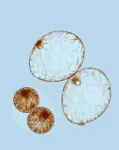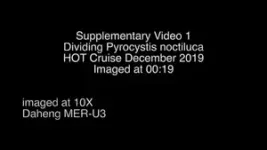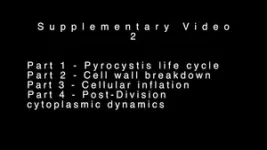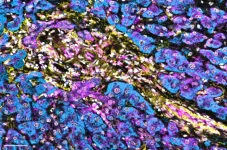(Press-News.org) Many plankton journey from the cold, dark depths of our oceans to the surface, only to eventually drift down again into the darkness in a perpetual rhythm. Yet, how single-celled phytoplankton, most of which have no appendages to help them swim, make this pilgrimage has remained a mystery. In a paper publishing October 17 in the Cell Press journal Current Biology, researchers describe a species of bioluminescent phytoplankton, called Pyrocystis noctiluca, that balloons to six times their original size of a few hundred microns. This massive inflation allows the plankton to journey up to 200 meters toward the ocean’s surface to capture sunlight, then sink back showcasing a unique strategy for long-distance ocean travel.
Phytoplankton are, on average, 5%–10% heavier than seawater, meaning that if they want to remain at the surface to photosynthesize, they have to find a way to best gravity. “We decided to work on things that seemingly have no appendages to swim,” says senior author Manu Prakash, a marine biologist and bioengineer at Stanford University. “What we have discovered in this paper is that these P. noctiluca cells are like little submarines that can control their density so precisely that they can choose where they want to be in the water column.”
On a research vessel off the coast of Hawaii, Prakash and a postdoctoral fellow at Stanford University, Adam Larson (@Planktonico), one of the first authors on the study, stumbled upon a bloom of P. noctiluca and surprisingly found two very different sizes in their nets. “It took a while to piece together why until we recorded the videos where we saw the cells doing this massive inflation,” says Larson. “It can happen quite suddenly, so if you sleep by the microscope for 10 minutes, you might miss it.”
To test what effects this rapid growth might have on the plankton, the research team utilized their novel “gravity machine.” “The gravity machine allows us to see a single cell at subcellular resolution in an infinite water column,” says Prakash. “It’s a little bit like a Ferris wheel for gerbils or mice but for a single cell. It’s the size of a dinner plate and rotates, so the cell doesn’t know that it’s not climbing or sinking in its own frame of reference.” By altering water pressure and density within the gravity machine, the team can create a virtual reality environment mimicking the ocean’s depths. With the machine, the team discovered that inflated cells were less dense than the surrounding seawater, letting them escape the downward pull of gravity and float toward the virtual surface.
Further investigation showed this expansion happens as a natural part of the plankton’s cell cycle. Once a single-celled plankton divides into two, an internal structure called a vacuole, a kind of flexible water tank, filters in fresh water, causing the two new cells to massively grow in size. These two daughter cells, now swelled with the lighter freshwater, sail upward. “What we realized is that this is a very clever way to essentially slingshot in the ocean during cell division,” Prakash says. “So, what happens during normal time? You’re making a lot of proteins, you have tons of sunlight, and you make a lot of biomass until you get heavier and you sink. Then, you do cell division in the deeper waters and use inflation to get back to the size of the mother.”
The entire cell cycle takes roughly 7 days, coinciding with the plankton’s vertical pursuit of light and nutrients. “You can then see how this cell cycle could have evolved,” says Prakash. “I think this is the first time we have clear evidence that the cell cycle, which is such a fundamental mechanism of controlling a cell and cell division, is possibly controlled by an ecological parameter.”
With these insights in mind, using a theoretical framework, the team discovered the ecological parameter acting as a fundamental limit driving this evolution. “All cells experience a gravitational pull downward, and unless they or subsequent progeny fight back, they will sink forever to the bottom of the ocean in a gravitational trap,” says postdoctoral fellow Rahul Chajwa, the other first author of the study, also at Stanford University. Now, using the results from the gravity machine, as well as their ecological and physiological observations, the research team has developed a mathematical framework that could be generalized and applied to all plankton in the ocean.
For future projects, Prakash’s lab is looking to uncover hidden mysteries of a vast number of plankton who may use the new biochemistry to regulate density and move up and down the water column. “We have roughly around 600 species in our Behavioral Atlas right now, and we are systematically measuring all kinds of mechanisms. It’s turning out that there are four or five different tricks all co-evolving for this function. I think one of the threads that’s really fun is that we have a long list of organisms to study; because there are millions of species that live in the ocean, this is the tip of the iceberg.”
Hongquan Li, a graduate student in the Prakash lab, is also an author on the study.
###
The research was primarily supported by the Simons Foundation and the International Human Frontier Science Program Organization. The team acknowleges further financial support from the Schmidt Futures Innovation Fellowship, the Moore Foundation, Dalio Philanthropies, the NSF Center for Cellular Construction, a NSF GCR Convergence Grant, and the Woods Institute for the Environment.
Current Biology, Larson et al.: “Inflation induced motility for long-distance vertical migration” https://www.cell.com/current-biology/fulltext/S0960-9822(24)01287-9
Current Biology (@CurrentBiology), published by Cell Press, is a bimonthly journal that features papers across all areas of biology. Current Biology strives to foster communication across fields of biology, both by publishing important findings of general interest and through highly accessible front matter for non-specialists. Visit: http://www.cell.com/current-biology. To receive Cell Press media alerts, contact press@cell.com.
END
Glioblastomas are aggressive brain tumors with a median survival time of less than 22 months despite standard therapy including surgery, irradiation, and chemotherapy. It has become clear in recent years that not all cells within the brain tumor have an equal potential to divide and drive tumor growth. As such, a fraction of tumor cells called brain tumor stem cells (BTSCs) are thought to be the primary origin of tumor re-growth after surgery in addition to being resistant to standard treatments including chemotherapy and irradiation. Therefore, targeting BTSCs may be a way to effectively treat glioblastomas.
In an effort to rapidly identify ...
It may soon be possible to determine which patients with a type of liver cancer called hepatocellular carcinoma would benefit from immunotherapy, according to a preclinical study by Weill Cornell Medicine investigators.
The study, published Oct. 17 in Molecular Cell, provides new insights into a pair of proteins, called p62 and NBR1, and their opposing functions in regulating the interferon response in hepatic stellate cells, a critical immune component in the liver’s fight against tumors. The study demonstrates that high levels of the immune-suppressing NBR1 in these specialized cells may identify patients who are unlikely to respond ...
About The Study: This meta-analysis found that an estimated 2.56% of people 40 years or older have glaucoma, slightly more than estimated by previous studies. Black individuals are disproportionately affected. Prevalence estimates at the state and county level can help guide public health planning.
Corresponding Author: To contact the corresponding author, Joshua R. Ehrlich, MD, MPH, email joshre@umich.edu.
To access the embargoed study: Visit our For The Media website at this link https://media.jamanetwork.com/
(doi:10.1001/jamaophthalmol.2024.3884)
Editor’s ...
About The Study: Electric fan use did not lower peak core temperature in older adults exposed to extreme indoor heat. Reductions in end-exposure core temperature and heart rate were observed, but they were small and of questionable clinical importance. Neither exceeded previous suggestions for clinical significance. Consistent with recent modeling, these data do not support fans as an efficacious standalone cooling intervention for older adults in hot indoor environments (>33-35 °C).
Corresponding Author: To contact the corresponding author, Glen P. Kenny, PhD, email gkenny@uottawa.ca.
To ...
About The Study: Individuals receiving methadone had a lower risk of treatment discontinuation compared with those who received buprenorphine/naloxone. The risk of mortality while receiving treatment was similar between medications.
Corresponding Author: To contact the corresponding author, Bohdan Nosyk, PhD, email bnosyk@sfu.ca.
To access the embargoed study: Visit our For The Media website at this link https://media.jamanetwork.com/
(doi:10.1001/jama.2024.16954)
Editor’s Note: Please see the article for additional information, including ...
Dusty ice exposed at the surface of Mars could provide the conditions necessary for the presence of photosynthetic life, according to a modelling study. The findings, published in Communications Earth & Environment, suggest that ice deposits located in the planet’s mid-latitudes should be a key location in any search for life on Mars.
High levels of harmful ultraviolet radiation from the Sun make current life on the surface of Mars almost certainly impossible. However, a sufficiently thick layer of ice can absorb this radiation and could protect cells living below its surface. Any life in these conditions ...
The Dream Chemistry Award (DCA) is a one-of-a-kind competition dedicated to recognizing young scientists who dream of tackling fundamental problems in chemistry and related disciplines with visionary ideas. Established in 2013 by the Institute of Physical Chemistry of the Polish Academy of Sciences (IChF), the award aims to support emerging talents in realizing their scientific dreams. Since 2017, it has been organized jointly with the Institute of Organic Chemistry and Biochemistry of the Czech Academy of Sciences (IOCB Prague), with the finals alternating between Prague and Warsaw.
The Dream Chemistry Award empowers those pursuing ...
In the high-stakes world of aviation, a pilot's ability to perform under stress can mean the difference between a safe flight and disaster. Comprehensive and precise training is crucial to equip pilots with the skills needed to handle these challenging situations.
Pilot trainers rely on augmented reality (AR) systems for teaching, by guiding pilots through various scenarios so they learn appropriate actions. But those systems work best when they are tailored to the mental states of the individual subject.
Enter HuBar, a novel visual analytics tool designed to summarize and compare task performance ...
Recently, a Chinese research team reported the discovery of abiotic organic compounds in the oceanic crust of the Southwest Indian Ridge and proposed a molecular mechanism for organic condensation.
This breakthrough followed the team’s discovery of nanoscale abiotic organic matter in mantle rocks from the Yap Trench in 2021. It represents a significant advance in research on deep-sea carbon cycling and the origin of life, shedding light on key pathways for abiotic organic synthesis in nature.
The scientists published their findings in the Proceedings ...
CHAMPAIGN, Ill. — By combining visible light and electrochemistry, researchers have enhanced the conversion of carbon dioxide into valuable products and stumbled upon a surprising discovery. The team found that visible light significantly improved an important chemical attribute called selectivity, opening new avenues not only for CO2 conversion but also for many other chemical reactions used in catalysis research and chemical manufacturing.
One way that chemists recycle CO2 into valuable products is through a process called electrochemical reduction, where a stream of CO2 gas moves through an electrolysis cell that breaks the CO2 and water ...






